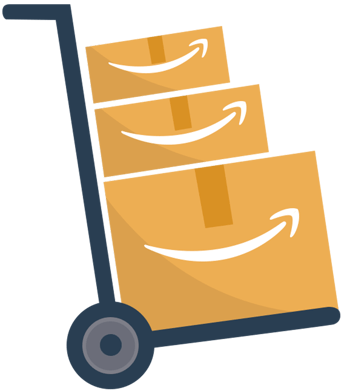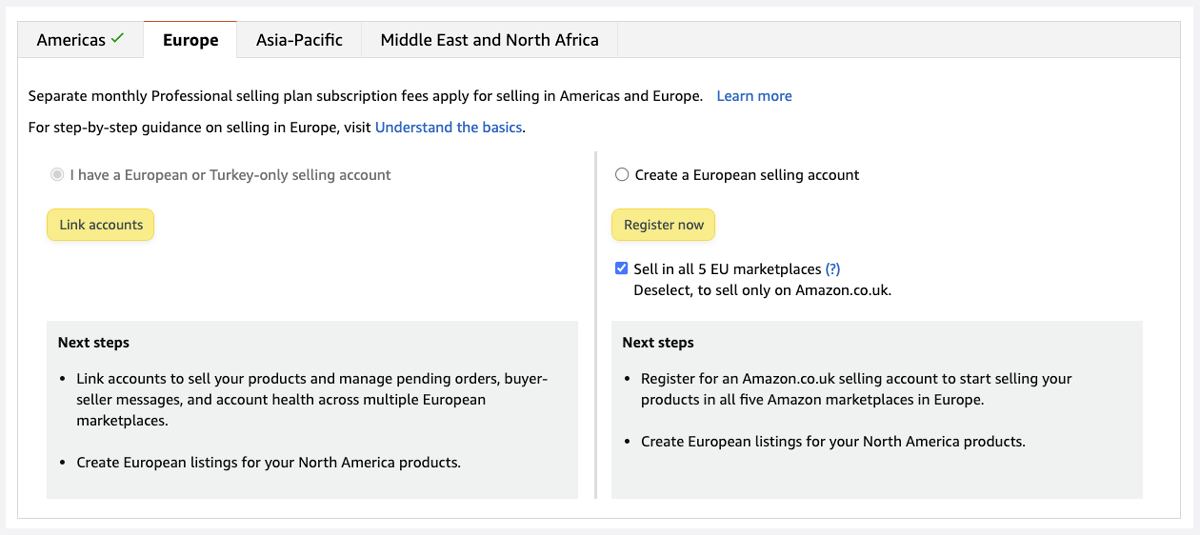Originally published on July 6, 2023, updated March 19, 2025
Menu
Join Our Email List
- Receive our monthly newsletter.
- Stay up to date on Amazon policies.
- Get tips to grow your business.
If you are currently an Amazon.com seller, expanding your business to Amazon EU can be a fantastic opportunity to reach a larger customer base and increase your sales in a new locale.
The world is your oyster, of course, but any business will want to assess the decision thoroughly before setting up shop abroad. While Amazon tries to make jumping across the pond (or to any new country) as simple as possible, some obstacles can’t be sailed through.
Businesses must consider some basic angles to decide what makes sense for their particular situation. These factors include general market research, account setup, compliance and legal considerations, pricing and currency, shipping and logistics, and marketing and promotion.
While each of these topics warrants deeper exploration, this article will give you a general overview of considerations any Amazon seller or vendor will want to explore when expanding to Amazon EU.
 Think of who, what, where, when, and why. Amazon Europe is not a monolith, and selling there actually gives you the option of selling to eight different marketplaces.
Think of who, what, where, when, and why. Amazon Europe is not a monolith, and selling there actually gives you the option of selling to eight different marketplaces.
Each marketplace has a different language and culture. What sells in one market might completely bomb in another. Amazon currently offers the opportunity to sell in the UK, Germany, France, Italy, Spain, the Netherlands, Poland, and Sweden. Starting with one or two marketplaces to test traction is ideal. The largest marketplaces are the UK and Germany, followed by France.
Next up, what to sell? Market research is crucial for any business, especially when expanding to a new country. To start, check on product restrictions.
Next, conduct market research to understand your European product demand. Identify your target audience, competitors, and market trends. Consider factors such as cultural differences, local regulations, and customer preferences.
For example, selling a hair dryer with a US plug in the EU isn’t going to work. Or, American footballs that sell well in Iowa aren’t necessarily going to be a hot item in the land of futbol. Is there a demand for your product in the locale you're entering?
Related reading: New EU General Product Safety Regulation: Key Changes Explained
Languages and legal systems differ, so your intellectual property will not automatically translate to another locale. As a brand owner, make sure to register your trademark to cover the countries you plan to sell in – you can do this at an EU or marketplace-specific level.
The EU ends up being cheaper, given the number of countries there. Understand that the UK is no longer part of the EU, and you will need to register a separate trademark in the UK.
Finally, do your brand and product names transition to another country and language? These basic needs should be the building blocks for success abroad.
Related reading: The Four Pillars of Intellectual Property on Amazon
Once you’ve established that the country and market will suit your business and brand, it’s time to create a seller account and jump through the regulatory hoops. Each country comes with its own legal and regulatory requirements.
Depending on the product, these can be basic or complex. For example, selling consumables, children’s or baby products, and anything that expires or has strict importation requirements will be more complicated no matter where you are in the world.
When venturing into the Amazon EU market, it's paramount to guarantee that your products comply with the regulations of both individual countries and the EU as a whole. Each country may have its specific requirements, and it's essential to adhere to the EU directives that relate to the category of products you offer.
For instance, in the grocery sector, it's mandatory to have all product labels written in the language of the marketplace where you're selling. In contrast, electronic devices and toys require CE markings, and the disposal of electrical and electronic equipment is subject to WEEE legislation. Moreover, it's prudent to familiarize yourself with consumer rights in the UK and EU, which differ from those in other international marketplaces, including the US.
Depending on your location, you will likely need to register for VAT (Value Added Tax) and obtain an EORI (Economic Operators' Registration and Identification) number. For comprehensive guidance on your legal tax obligations in various European countries, it's advisable to seek assistance from a tax advisor. Reputable companies include SimplyVAT and Avalara.
Editor's note: You can also find various tax and legal experts on eComEngine's Partners Page.
Tax consultants will possess the expertise to determine the specific countries where you need to register for VAT and aid in the registration process. The choice of your seller program and inventory storage location will influence these requirements.
Moreover, they can offer ongoing support in managing your returns with government tax offices. Additionally, they will assist you in obtaining an EORI number, which is necessary for importing goods and fulfilling customs requirements in both the UK and the EU.
When you sell in Amazon Europe, you will conduct transactions in two different currencies besides your USD: the UK pound sterling (GBP) for the UK marketplace and euros for other European countries.
Trading in foreign currencies entails the possibility of gains or losses when converting the funds back into US dollars or your home currency, along with additional foreign exchange costs. While you could use your home bank account to receive funds, this option usually involves higher fees and less favorable exchange rates.
Using a service such as Payoneer, which can serve as a local bank account, can lower fees. Companies like Payoneer can receive and hold the funds in the local currency and subsequently convert and transfer them to your home bank account, providing you with more competitive rates and reduced fees. This approach can help optimize your currency exchange process when operating in multiple European marketplaces.
 Your next decision for expanding into Amazon EU will be to choose the order management method: Fulfillment by Amazon (FBA), Merchant Fulfilled Network (MFN), or Seller Fulfilled Prime (SFP).
Your next decision for expanding into Amazon EU will be to choose the order management method: Fulfillment by Amazon (FBA), Merchant Fulfilled Network (MFN), or Seller Fulfilled Prime (SFP).
If you opt for MFN, you should avoid fulfilling orders directly from the US and consider partnering with a third-party logistics provider (3PL) based in Europe. While it may be feasible for certain product categories, fulfilling orders directly from the US carries a high risk of customs delays, leading to a negative customer experience, potential negative seller feedback, and difficulty meeting seller performance metrics.
If your long-term plans involve transitioning to SFP, ensure that the chosen 3PL can fulfill the shipping requirements for the countries you serve. Like in the US, choosing Amazon FBA is often the easiest and most customer-friendly option for international sellers launching in Europe.
As a US seller, Amazon allows you to create a global selling account using the same email address. When you’re ready, create an EU account from within your Seller Central account in the Inventory section in the menu bar. Select Sell Globally, then select and register for Europe.

Translation requires a bit more than simply copying and pasting. Once your business is set up, you will need to work to promote and market your items to local consumers.
Amazon offers the Build International Listings (BIL) tool within Seller Central, but it is usually best to do it manually. Accuracy and attention to detail will ensure your listings perform as well as possible and be translated and localized into the target marketplace.
To maximize the performance of your listings, optimizing them for search in each country is crucial. This involves incorporating local search terms that align with customers' preferences, enabling them to discover your products easily in search and browse.
To achieve this, consider employing native translators or translators who possess proficiency and can localize. This process is equally important in the UK market, as numerous words and phrases in the US may not translate effectively or resonate with the UK audience. By ensuring proper localization, you can enhance the relevance and appeal of your product listings and connect with customers in each country.
Keep reading: Three Tips for Stronger Amazon Listing Translations
If you’re ready to embark on your international journey but need help with one or more areas (from account setup to advertising and listing optimization), eCommerce Nurse can help. Get it right from the start, and maximize sales when selling in the EU and beyond with our experts.
Originally published on July 6, 2023, updated March 19, 2025
This post is accurate as of the date of publication. Some features and information may have changed due to product updates or Amazon policy changes.
These Stories on International
14321 Winter Breeze Drive
Suite 121 Midlothian, VA 23113
Call us: 800-757-6840





Copyright© 2007-2025 eComEngine, LLC. All Rights Reserved. eComEngine®, FeedbackFive®, RestockPro®, and SellerPulse® are trademarks or registered trademarks of eComEngine, LLC. Amazon's trademark is used under license from Amazon.com, Inc. or its affiliates.
No Comments Yet
Let us know what you think